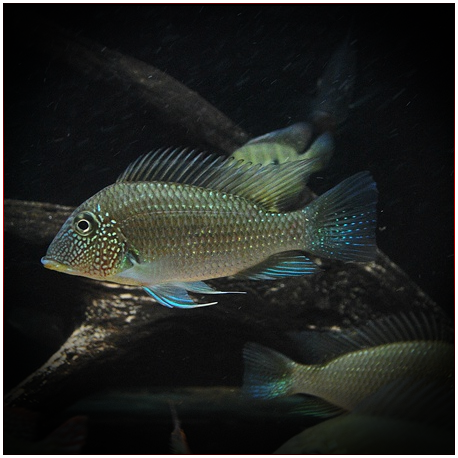More info
Datasheet
| Minimum Tank Size | 650 litres / 171.71 US gallons |
| Maximum Size | 15.0cm / 5.91inches |
| Temperature | 22°C / 71.60°F - 28°C / 82.40°F |
| Hardness | 2.02dgH / 36ppm - 12.05dgH / 215ppm |
| pH | 5.5-7.5 |
General DescriptionSatanoperca Mapiritensis, also known as Geophagus mapiritensis, belongs to the Cichlidae family and hails from the lower Río Orinoco basin in Venezuela. These fish typically reach sizes of up to 15.0cm and are characterized by a distinctive color pattern with white spots and vermiculations on the head, as well as pale orange lips. The exact taxonomic classification of this species remains a subject of ongoing study.
Aquarium SetupThe ideal tank setup for Satanoperca Mapiritensis includes a soft, sandy substrate to facilitate their natural browsing behavior. Coarser substrates like gravel can hinder feeding and cause harm if ingested. Dim lighting, driftwood pieces, and scattered roots or branches are recommended decor items. Leaf litter, although present in their natural habitat, is discouraged in aquariums due to potential filtration issues caused by their feeding behavior. Maintaining high water quality through adequate filtration and regular water changes is crucial for the health of these cichlids.
BehaviourSatanoperca Mapiritensis is generally peaceful, with minimal predation on fish larger than a few millimeters. They thrive best in groups of 5-8 individuals, displaying a noticeable dominance hierarchy within the group. Aggressive or territorial tankmates should be avoided, while peaceful species with similar environmental preferences make suitable companions. Individual specimens can exhibit excessive antagonism in smaller groups, emphasizing the importance of maintaining adequate numbers.
Feeding and DietAs benthophagous "eartheaters," Satanoperca species sift through substrate in search of food, expelling excess material through their gills and mouth. Their diet consists of small aquatic and terrestrial invertebrates, plant material, organic detritus, and sediment. In captivity, a varied diet of high-quality prepared foods, live or frozen options like bloodworms and Artemia, and plant matter is recommended. Offering multiple small meals daily aligns with their natural browsing behavior and contributes to optimal growth and health.
Reproduction & DimorphismReported reproductive behavior for Satanoperca Mapiritensis is unconfirmed, with potential misidentifications within the upper Orinoco basin. Sexual dimorphism details are not available for this species. The genus Satanoperca encompasses diverse groups with distinctive color patterns and different reproductive strategies, including mouthbrooders and substrate spawners, reflecting their evolutionary adaptations to varied habitats.
Habitat and DistributionSatanoperca Mapiritensis inhabits main river channels, tributaries, and floodplain lakes in the lower Río Orinoco basin, particularly in Venezuela's Anzoátegui, Monagas, and Bolívar states. They prefer sandy or muddy substrates with leaf litter and submerged tree branches. Similar-looking populations in drainages towards Guyana raise questions of conspecificity. Other populations in the middle and upper Orinoco, sometimes misidentified as S. mapiritensis, add to the species' distribution complexity.

